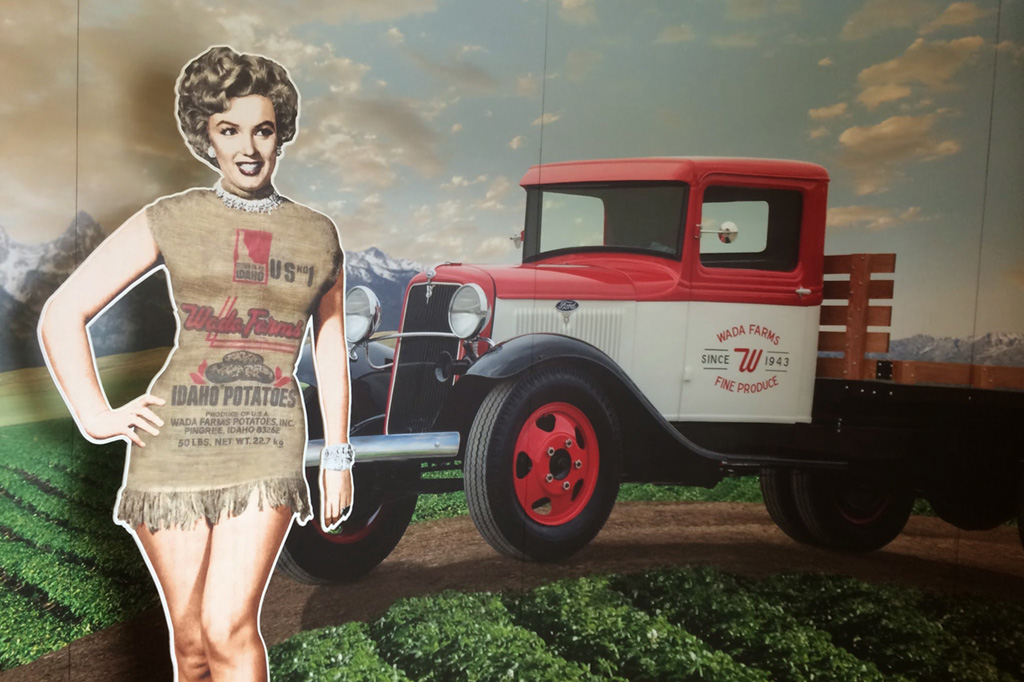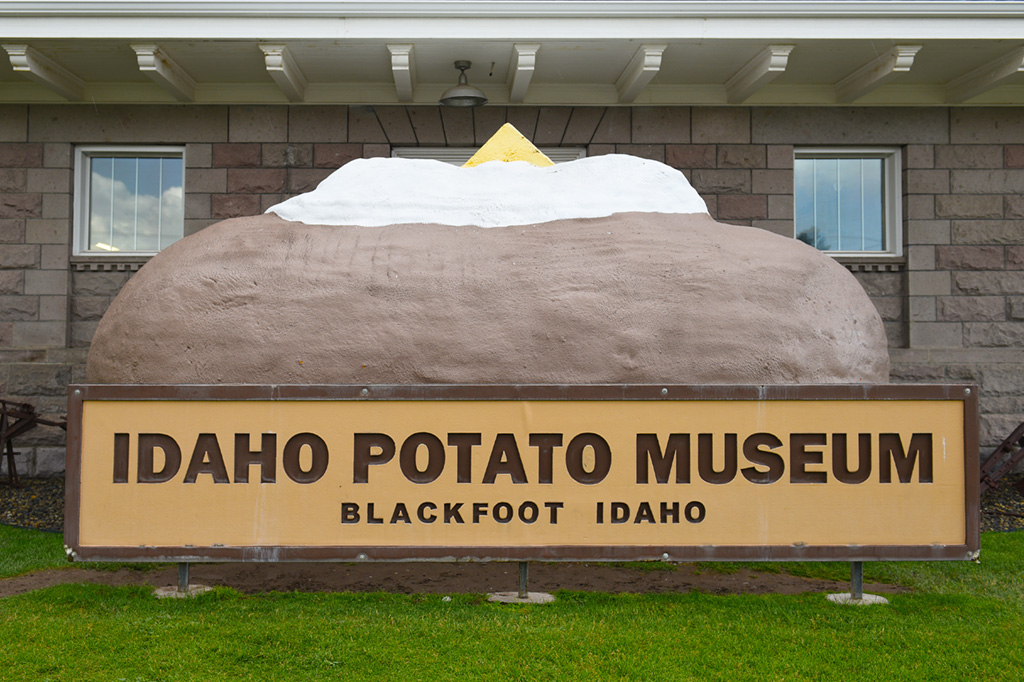Idaho is synonymous with potatoes. Nine out of 10 Americans say they associate potatoes with Idaho more than any other state in the nation, while 72 percent of Americans would be inclined to eat Idaho® potatoes over potatoes from any other state. This is in no small part the result of the efforts of a segment of the Idaho potato industry: the Idaho Potato Commission. This state agency was started in 1937 to build the Idaho potato brand. It’s funded by a tax on all Idaho-grown potatoes, and used to market and protect the registered certification marks “Idaho® Potatoes” and “Grown in Idaho®.”
On a recent visit to the Idaho Potato Museum in Blackfoot, I learned that not only is Idaho the potato capital of the world, but Bingham County produces more potatoes than any other county in the United States–100 million hundredweight sacks per year. The museum, and thus Bingham County, also may be home to the most potato-related kitsch in the world, from chocolate-covered potato chips to T-shirts with a potato dressed up as Marilyn Monroe with the phrase “some like it hot” printed below.
“The museum used to have the biggest potato in the world,” said Tish Dahmen, executive director of the Idaho Potato Museum. “Now the Idaho Potato Commission has built a bigger one.” She gestured toward the oversized potato parked outside the museum. “I’d like to get an even bigger one made, but for now I’ll have to live with the fact that we have the largest potato with butter.”
Dahmen thinks potatoes have received bad publicity in the past because one of the most common ways Americans eat them is fried. But the potato is good for you, she said. It’s a great source of fiber, B6, and manganese, and it has more potassium than a banana and more vitamin C than an orange. Dahmen likes to call the potato the “perfect food,” because it is grown and eaten all over the world, it’s easy to ship and easy to store. The potato, she said, “connects everybody. It’s so universal.”
Bingham County wasn’t always the epicenter of potato production. Potatoes have their roots in the rugged terrain of the Andes Mountains in South America. Earliest archaeological evidence of cultivated tubers dates back at least 7,000 years. This unlikely birthplace for today’s fifth most important staple crop nourished the people of South America for centuries, including the Incas, who had access to up to at least 5,000 varieties. They even developed a technique for dehydrating the potato for easy transport and increased shelf life, a technique Western culture didn’t master until the 1940s.
The Spanish discovered the potato in 1537 and brought some back to Europe. The potato was an important introduction to a land plagued with frequent famine. Europeans did not immediately welcome the potato, despite how easy it was to grow, and its high nutritional value. Farmers regarded this crop with fascination and suspicion, rumored by some to be an aphrodisiac. Others believed it to be a cause of fever or leprosy. According to museum lore, in England, the Society for the Prevention of Unwholesome Diets, or SPUD (hence the nickname), considered it poisonous and evil.
With the help of a few forward-thinking individuals, the potato began to spread across Europe. King Frederick the Great, for example, ordered the peasants to eat potatoes when Prussia was hit by famine in 1744. Antoine-Augustin Parmentier in France tirelessly promoted the potato as a solution to France’s constant famines (he’d survived on potatoes when held captive by the Prussians during the Seven Years’ War). In addition to planting acres of potatoes at the edge of Paris with the hope that the famished masses would steal them for sustenance (unwittingly creating the monoculture we know today by planting pieces of tuber rather than seeds, resulting in clones sprouting), he also set up publicity stunts to promote the tuber. He prepared all-potato dinners for high-society guests. Thomas Jefferson is said to have attended and was delighted by the French fries. Jefferson allegedly introduced these French fries to Americans when he served them at a White House dinner, to which John Adams accused Jefferson of putting on airs by serving “such novelties.”
French fries have come a long way in 200 years, as have potatoes. Today, potatoes are America’s favorite vegetable, with the average American eating about 110 pounds of potatoes a year. Ninety-seven percent of Americans eat potatoes. That means, as a nation, we consume around 25.3 billion pounds of potatoes a year. Idaho harvests 13 billion pounds of potatoes a year—that’s more than half the amount of potatoes America consumes annually.
Idaho is said to be the “optimum growing region” because of its rich volcanic soil, consistent warm days and cool nights, clean and plentiful water. According to James W. Davis, author of “Aristocrat in Burlap: A History of the Potato in Idaho,” the potato industry developed in Idaho via Mormon pioneers. Henry Spalding, a Presbyterian missionary, planted the first potatoes in Idaho, with the help of the Nez Perce Indians. The first year he could hardly grow enough to eat. But by 1838, Spalding and the Nez Perce had a large potato harvest, with at least 1,500 bushels.
Although the Nez Perce grew enough to trade potatoes for goods from pioneers traveling west in wagon trains, the potato industry didn’t really take off until gold was discovered in Idaho in 1860. Early potato production boomed as it sustained the miners in the Wood River District, Silver City, and Boise Basin. In 1872, American horticulturist Luther Burbank developed the Russet Burbank potato we know today, and sold the rights for $150. This variety began appearing throughout Idaho by the 1900s.
At the turn of the century, Idaho newspapers began suggesting that “evaporation” could make the transportation of potatoes easier and less costly. J.R. Simplot put this idea into practice in 1942; the army had requested he use the same dehydration technique on potatoes he used on onions. The technique worked, and Simplot built a dehydrator in Blackfoot and one in Bakersfield, Calif. Dehydrated potatoes were so successful that American servicemen in World War II were sick of them by the end of the war. Simplot began experimentation on potato processing that ended in the mass production of the French fry.

When a journalist once suggested that Marilyn Monroe would look good in a potato sack, she responded by posing for a photo in one. So the museum sells potato sack dresses. They come in two sizes, 50 and 100 pounds.
If there is a vegetable that inspires a sense of humor, it’s the potato. A Bingham County farmer, who invented the automatic conveyor belt to move potatoes onto the truck because he was too short to reach the top, named his machine the “Spudnik” (it was invented around the same time as the Sputnik). The museum sells shirts with “Spud Bob Starch Pants” and “Darth Tater.” They also have an old desiccated potato with Dan Quayle’s signature on it. When a journalist once suggested that Marilyn Monroe would look good in a potato sack, she responded by posing for a photograph in one. So the museum sells potato sack dresses. They come in two sizes, 50 and 100 pounds. The museum also houses the world’s largest potato crisp, but Dahmen says she’s disappointed. It’s 26 years old and cracked. She’s been trying to contact Pringles to get a new crisp made, but they’ve been unresponsive. “I thought Pringles would want to hear from me, but apparently not.”
If you’re curious about a unique way to make potatoes, Dahmen offered a recipe common to southeast Idaho, nicknamed “funeral potatoes” because it’s a dish people in the region bring to a wake: Layer frozen hash browns, cream of mushroom soup, a layer of cheddar cheese, sour cream, and then top it off with potato chips or cornflakes for an extra crunch, and bake it.
If you’re into vegetable humor or have an ongoing love affair with the potato, the Idaho Potato museum is worth a stop. Entry into the Museum comes with “taters for out-of-staters,” aka a box of dehydrated hash browns.


